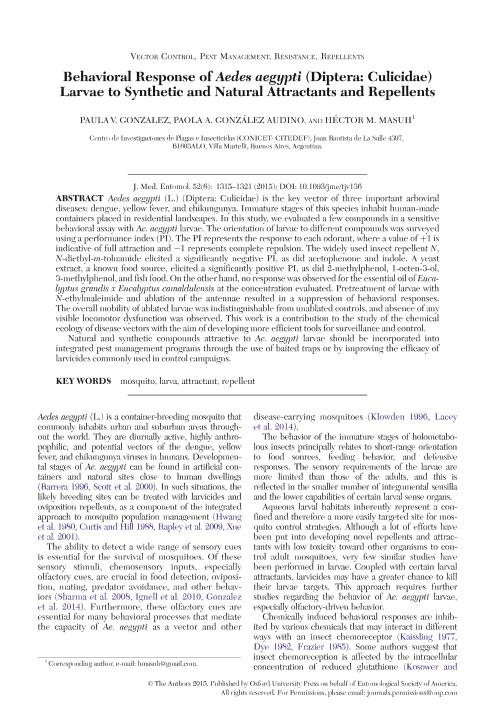Mostrar el registro sencillo del ítem
dc.contributor.author
Gonzalez, Paula Valeria

dc.contributor.author
Gonzalez Audino, Paola Andrea

dc.contributor.author
Masuh, Hector Mario

dc.date.available
2018-04-16T20:58:18Z
dc.date.issued
2015-09
dc.identifier.citation
Gonzalez, Paula Valeria; Gonzalez Audino, Paola Andrea; Masuh, Hector Mario; Behavioral Response of Aedes aegypti (Diptera: Culicidae) Larvae to Synthetic and Natural Attractants and Repellents; Entomological Society of America; Journal of Medical Entomology; 52; 6; 9-2015; 1315-1321
dc.identifier.issn
0022-2585
dc.identifier.uri
http://hdl.handle.net/11336/42213
dc.description.abstract
Aedes aegypti (L.) (Diptera: Culicidae) is the key vector of three important arboviral diseases: dengue, yellow fever, and chikungunya. Immature stages of this species inhabit human-made containers placed in residential landscapes. In this study, we evaluated a few compounds in a sensitive behavioral assay with Ae. aegypti larvae. The orientation of larvae to different compounds was surveyed using a performance index (PI). The PI represents the response to each odorant, where a value of + 1 is indicative of full attraction and -1 represents complete repulsion. The widely used insect repellent N, N-diethyl-m-toluamide elicited a significantly negative PI, as did acetophenone and indole. A yeast extract, a known food source, elicited a significantly positive PI, as did 2-methylphenol, 1-octen-3-ol, 3-methylphenol, and fish food. On the other hand, no response was observed for the essential oil of Eucalyptus grandis x Eucalyptus camaldulensis at the concentration evaluated. Pretreatment of larvae with N-ethylmaleimide and ablation of the antennae resulted in a suppression of behavioral responses. The overall mobility of ablated larvae was indistinguishable from unablated controls, and absence of any visible locomotor dysfunction was observed. This work is a contribution to the study of the chemical ecology of disease vectors with the aim of developing more efficient tools for surveillance and control. Natural and synthetic compounds attractive to Ae. aegypti larvae should be incorporated into integrated pest management programs through the use of baited traps or by improving the efficacy of larvicides commonly used in control campaigns.
dc.format
application/pdf
dc.language.iso
eng
dc.publisher
Entomological Society of America

dc.rights
info:eu-repo/semantics/openAccess
dc.rights.uri
https://creativecommons.org/licenses/by-nc-sa/2.5/ar/
dc.subject
Mosquito
dc.subject
Larva
dc.subject
Attractant
dc.subject
Repellent
dc.subject.classification
Otras Ciencias Biológicas

dc.subject.classification
Ciencias Biológicas

dc.subject.classification
CIENCIAS NATURALES Y EXACTAS

dc.title
Behavioral Response of Aedes aegypti (Diptera: Culicidae) Larvae to Synthetic and Natural Attractants and Repellents
dc.type
info:eu-repo/semantics/article
dc.type
info:ar-repo/semantics/artículo
dc.type
info:eu-repo/semantics/publishedVersion
dc.date.updated
2018-04-12T14:32:58Z
dc.journal.volume
52
dc.journal.number
6
dc.journal.pagination
1315-1321
dc.journal.pais
Estados Unidos

dc.description.fil
Fil: Gonzalez, Paula Valeria. Consejo Nacional de Investigaciones Científicas y Técnicas. Unidad de Investigación y Desarrollo Estratégico para la Defensa. Ministerio de Defensa. Unidad de Investigación y Desarrollo Estratégico para la Defensa; Argentina
dc.description.fil
Fil: Gonzalez Audino, Paola Andrea. Consejo Nacional de Investigaciones Científicas y Técnicas. Unidad de Investigación y Desarrollo Estratégico para la Defensa. Ministerio de Defensa. Unidad de Investigación y Desarrollo Estratégico para la Defensa; Argentina
dc.description.fil
Fil: Masuh, Hector Mario. Consejo Nacional de Investigaciones Científicas y Técnicas. Unidad de Investigación y Desarrollo Estratégico para la Defensa. Ministerio de Defensa. Unidad de Investigación y Desarrollo Estratégico para la Defensa; Argentina
dc.journal.title
Journal of Medical Entomology

dc.relation.alternativeid
info:eu-repo/semantics/altIdentifier/doi/http://dx.doi.org/10.1093/jme/tjv136
dc.relation.alternativeid
info:eu-repo/semantics/altIdentifier/url/http://www.bioone.org/doi/abs/10.1093/jme/tjv136
Archivos asociados
